CFD Simulation of a 3D Solar Chimney Integrated with an Axial Turbine for Power Generation
Abstract
:1. Introduction
2. Methodology of Simulation
2.1. Numerical Procedure
2.2. Governing Equation
2.3. Boundary Conditions
3. Calibration of Numerical Model
4. Weather Data for Numerical Simulation
5. Results and Discussion
5.1. Velocity at Chimney Base
5.2. Temperature Inside the Collector
5.3. Temperature Inside the Chimney
5.4. Velocity Inside the Chimney
5.5. Velocity along Collector Diameter
5.6. Power Output
- (a)
- Reversible power. In Figure 15, the kinetic energy available from the system, called the reversible power of the system, is shown. This power is known to be the maximum power that can be achieved in the region of the turbine, which depends on the turbine’s volumetric flow rate and pressure difference.
- (b)
- Actual turbine power. The actual power resulting from the wind turbine mounted at the chimney base is shown in Figure 17. The result is that the maximum usable power of the turbine is multiplied by the efficiency of the turbine, which is lower than the reversible power due to the nonideal efficiency of the turbine and the losses in the rotation shaft. The daily electrical energy generated by the wind turbine for all months is shown in Figure 18.


6. Conclusions
- The numerical simulation in this examination gave a good agreement with results of the Manzanares power plant.
- It was observed that the maximum temperature in the collector outlet was 329.05 K in summer in the month of July due to the high solar radiation and ambient temperature in this month.
- The results also showed that the maximum air velocity at the turbine was graded according to the seasons of the year and it was observed as 18.28 m/s in July due to the high ambient temperature in this month.
- The overall average daily and monthly energy production for the Kirkuk system were found to be 310 kWh/day and 9314 kWh/month, respectively.
- The final and the most important yield required from this system was to check its productivity of electricity, and it was found that the electricity produced from the system of Kirkuk city varied to be a maximum of 14,424 kWh/month in July.
Author Contributions
Funding
Institutional Review Board Statement
Informed Consent Statement
Data Availability Statement
Acknowledgments
Conflicts of Interest
References
- Owusu, P.A.; Asumadu-Sarkodie, S. A review of renewable energy sources, sustainability issues and climate change mitigation. Cogent Eng. 2016, 3, 1167990. [Google Scholar] [CrossRef]
- Wang, H.; Yang, X.; Lou, Q.; Xu, X. Achieving a Sustainable Development Process by Deployment of Solar PV Power in ASEAN: A SWOT Analysis. Processes 2021, 9, 630. [Google Scholar] [CrossRef]
- Durganjali, C.S.; Bethanabhotla, S.; Kasina, S.; Radhika, S. Recent Developments and Future Advancements in Solar Panels Technology. J. Physics Conf. Ser. 2020, 1495, 012018. [Google Scholar] [CrossRef]
- Ahuja, D.; Tatsutani, M. Sustainable energy for developing countries. S.A.P.I.EN.S. Surv. Perspect. Integr. Environ. Soc. 2009, 2, 1. [Google Scholar]
- Dhahri, A.; Omri, A. A review of solar chimney power generation technology. Int. J. Eng. Adv. Technol. 2013, 2, 1–17. [Google Scholar] [CrossRef]
- Pasad, D. Solar Power; The Images Publishing Group Pty Ltd.: New York, NY, USA; Earthscan: London, UK, 2005. [Google Scholar]
- Bergermann Solar. Solar Updraft Tower; Schlaich Bergermann Solar GmbH: Stuttgart, Germany, 2011. [Google Scholar]
- von Backström, T.; Gannon, A. Solar chimney turbine characteristics. Sol. Energy 2004, 76, 235–241. [Google Scholar] [CrossRef]
- Kazem, H.A.; Chaichan, M.T. Status and future prospects of renewable energy in Iraq. Renew. Sustain. Energy Rev. 2012, 16, 6007–6012. [Google Scholar] [CrossRef]
- Gholamalizadeh, E.; Chung, J.D. Analysis of fluid flow and heat transfer on a solar updraft tower power plant coupled with a wind turbine using computational fluid dynamics. Appl. Therm. Eng. 2017, 126, 548–558. [Google Scholar] [CrossRef]
- Bouabidi, A.; Nasraoui, H.; Ayadi, A.; Driss, Z.; Abid, M.S. Numerical analysis of chimney diameter effect on the fluid flow and the heat transfer characteristics within the solar tower. Energy Sources Part A Recover. Util. Environ. Eff. 2019, 41, 2494–2506. [Google Scholar] [CrossRef]
- Rabehi, R.; Chaker, A.; Aouachria, Z.; Tingzhen, M. CFD analysis on the performance of a solar chimney power plant system: Case study in Algeria. Int. J. Green Energy 2017, 14, 971–982. [Google Scholar] [CrossRef]
- Ismail, A.; Hamed, A.M.; Hussin, A.M.T.A.E. Numerical modeling for a solar chimney. J. Al-Azhar Univ. Eng. Sect. 2019, 14, 87–98. [Google Scholar] [CrossRef] [Green Version]
- Djaouida, B.; Aouachria, Z.; Benmachiche, A.H.; Ali, S. Controlling power output of solar chimney power plant according to demand. Int. J. Ambient. Energy 2018, 41, 1467–1481. [Google Scholar] [CrossRef]
- Hassan, A.; Ali, M.; Waqas, A. Numerical investigation on performance of solar chimney power plant by varying collector slope and chimney diverging angle. Energy 2018, 142, 411–425. [Google Scholar] [CrossRef]
- Guo, P.; Li, J.-Y.; Wang, Y. Numerical simulations of solar chimney power plant with radiation model. Renew. Energy 2014, 62, 24–30. [Google Scholar] [CrossRef]
- Das, P.; Chandramohan, V.P. CFD analysis on flow and performance parameters estimation of solar updraft tower (SUT) plant varying its geometrical configurations. Energy Sources Part A Recover. Util. Environ. Eff. 2018, 40, 1532–1546. [Google Scholar] [CrossRef]
- Zuo, L.; Dai, P.; Yan, Z.; Li, C.; Zheng, Y.; Ge, Y. Design and optimization of turbine for solar chimney power plant based on lifting design method of axial-flow hydraulic turbine impeller. Renew. Energy 2021, 171, 799–811. [Google Scholar] [CrossRef]
- De_Richter, R.; Ming, T.; Davies, P.; Liu, W.; Caillol, S. Removal of non-CO2 greenhouse gases by large-scale atmospheric solar photocatalysis. Prog. Energy Combust. Sci. 2017, 60, 68–96. [Google Scholar] [CrossRef]
- dos Santos Bernardes, M.A. Solar chimney power plants–developments and advancements. Sol. Energy 2010, 84, 953–978. [Google Scholar] [CrossRef] [Green Version]
- Chikere, A.O.; Al-Kayiem, H.H.; Karim, Z.A.A. Review on the Enhancement Techniques and Introduction of an Alternate Enhancement Technique of Solar Chimney Power Plant. J. Appl. Sci. 2011, 11, 1877–1884. [Google Scholar] [CrossRef] [Green Version]
- Esmail, M.F.; A-Elmagid, W.; Mekhail, T.; Al-Helal, I.; Shady, M. A numerical comparative study of axial flow turbines for solar chimney power plant. Case Stud. Therm. Eng. 2021, 26, 101046. [Google Scholar] [CrossRef]
- Zuo, L.; Liu, Z.; Dai, P.; Qu, N.; Ding, L.; Zheng, Y.; Ge, Y. Economic performance evaluation of the wind supercharging solar chimney power plant combining desalination and waste heat after parameter optimization. Energy 2021, 227, 120496. [Google Scholar] [CrossRef]
- Setareh, M. Comprehensive mathematical study on solar chimney powerplant. Renew. Energy 2021, 175, 470–485. [Google Scholar] [CrossRef]
- Singh, A.P.; Kumar, A.; Singh, O. A novel concept of integrating bell-mouth inlet in converging-diverging solar chimney power plant. Renew. Energy 2020, 169, 318–334. [Google Scholar] [CrossRef]
- Torabi, R.M.; Hosseini, M.; Akbari, O.A.; Afrouzi, H.H.; Toghraie, D.; Kashani, A.; Alizadeh, A. Investigation the performance of solar chimney power plant for improving the efficiency and increasing the outlet power of turbines using computational fluid dynamics. Energy Rep. 2021, 7, 4555–4565. [Google Scholar] [CrossRef]
- Semai, H.; Bouhdjar, A. Effect of slope tower angle and thermal storage media on flexibility solar chimney power plant performance. Environ. Prog. Sustain. Energy 2021, e13646. [Google Scholar] [CrossRef]
- Cuce, E.; Saxena, A.; Cuce, P.M.; Sen, H.; Guo, S.; Sudhakar, K. Performance assessment of solar chimney power plants with the impacts of divergent and convergent chimney geometry. Int. J. Low-Carbon Technol. 2021, ctaa097. [Google Scholar] [CrossRef]
- Ali, S.; Djaouida, B.; Benmachiche, A.H.; Aouachria, Z. Performance analysis of a solar chimney power plant system in two Algeria regions. Int. J. Ambient. Energy 2021, 1–12. [Google Scholar] [CrossRef]
- Semai, H.; Bouhdjar, A. Impact of the chimney geometry on the power output of solar chimney power plant. Thermophys. Aeromechanics 2021, 28, 291–303. [Google Scholar] [CrossRef]
- Wang, H.; Chen, J.; Dai, P.; Zhang, F.; Li, Q. Simulation and Experimental Study of the Influence of the Baffles on Solar Chimney Power Plant System. Processes 2021, 9, 902. [Google Scholar] [CrossRef]
- Arzpeyma, M.; Mekhilef, S.; Newaz, K.M.S.; Horan, B.; Seyedmahmoudian, M.; Akram, N.; Stojcevski, A.; Alnaimat, F.; Mathew, B. Numerical simulation of the effect of chimney configuration on the performance of a solar chimney power plant. J. Therm. Anal. Calorim. 2021, 1–15. [Google Scholar] [CrossRef]
- Guo, P.; Li, J.; Wang, Y.; Wang, Y. Numerical study on the performance of a solar chimney power plant. Energy Convers. Manag. 2015, 105, 197–205. [Google Scholar] [CrossRef]
- Ming, T.; Liu, W.; Pan, Y.; Xu, G. Numerical analysis of flow and heat transfer characteristics in solar chimney power plants with energy storage layer. Energy Convers. Manag. 2008, 49, 2872–2879. [Google Scholar] [CrossRef]
- Haaf, W. Solar Chimneys: Part II: Preliminary Test Results from the Manzanares Pilot Plant. Int. J. Sol. Energy 1984, 2, 141–161. [Google Scholar] [CrossRef]
- Huld, T.; Šúri, M.; Dunlop, E.; Albuisson, M.; Wald, L. Integration of HelioClim-1 database into PVGIS to estimate solar electricity potential in Africa. In Proceedings of the 20th European Photovoltaic Solar Energy Conference and Exhibition, Barcelona, Spain, 6–10 June 2005; pp. 2989–2992. [Google Scholar]
- Hafizh, H.; Shirato, H.; Yui, D. Performance Analysis of Solar Updraft Power Generator in Indonesia. KnE Eng. 2016, 1, 1–6. [Google Scholar] [CrossRef] [Green Version]


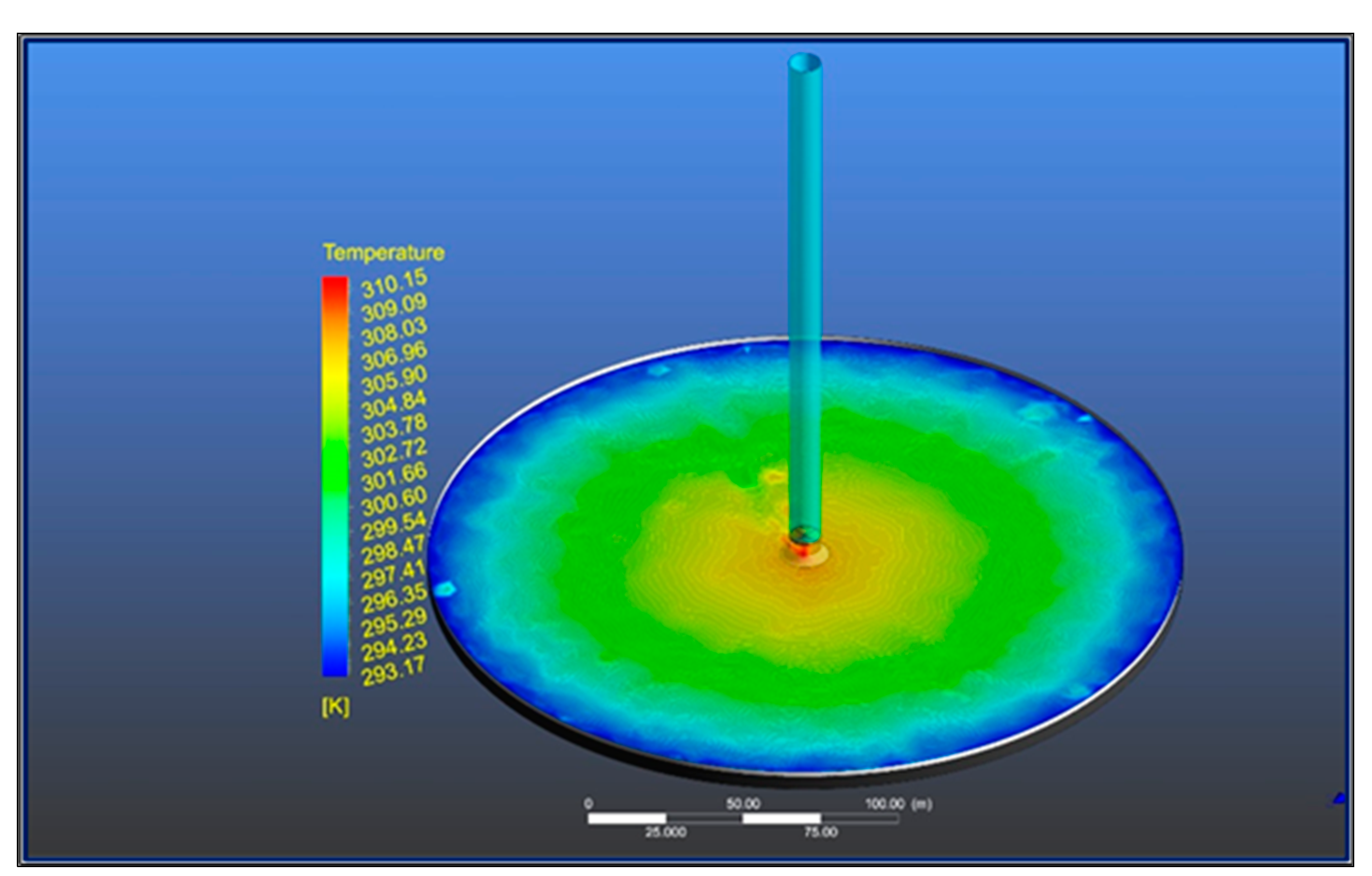
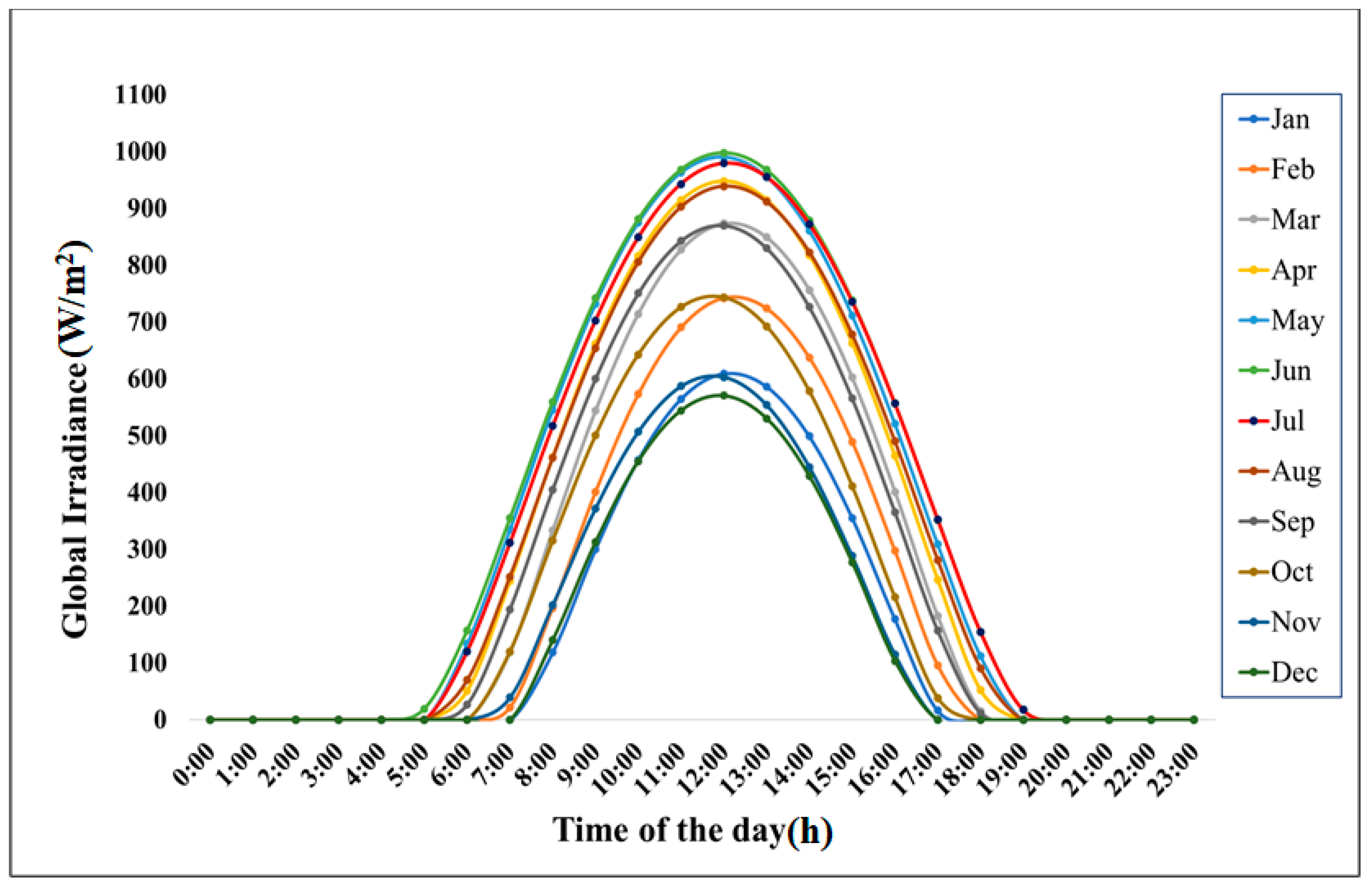


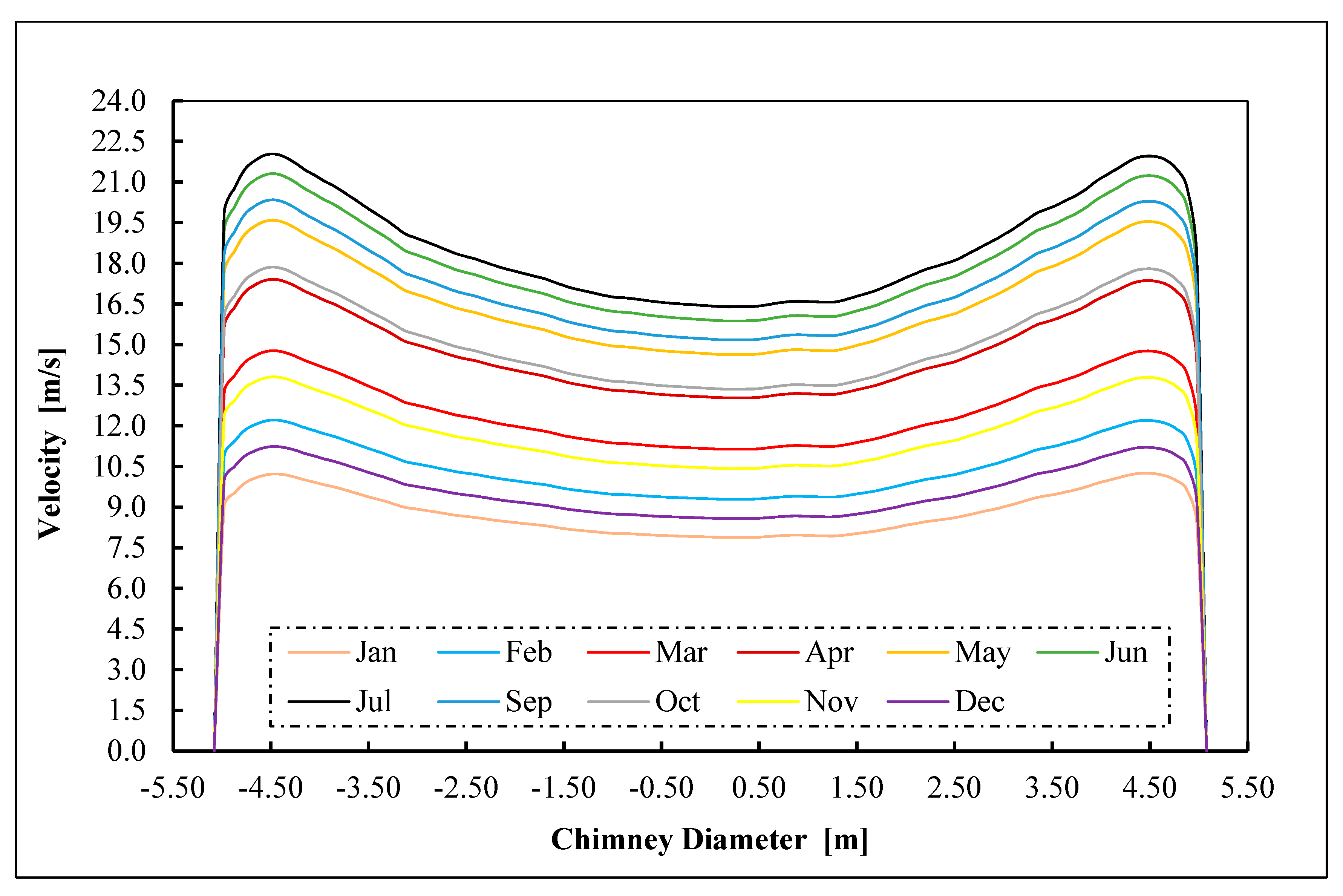



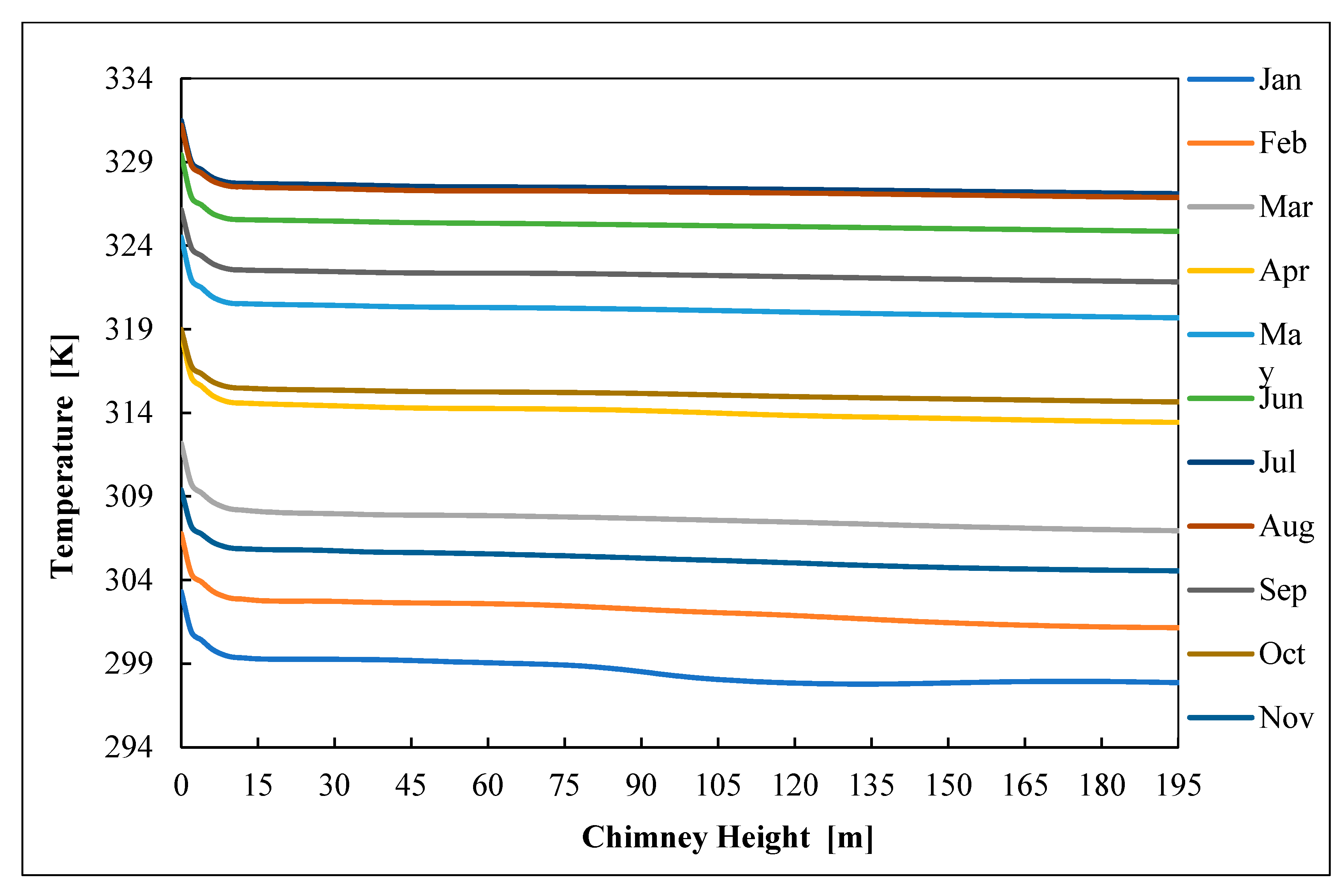

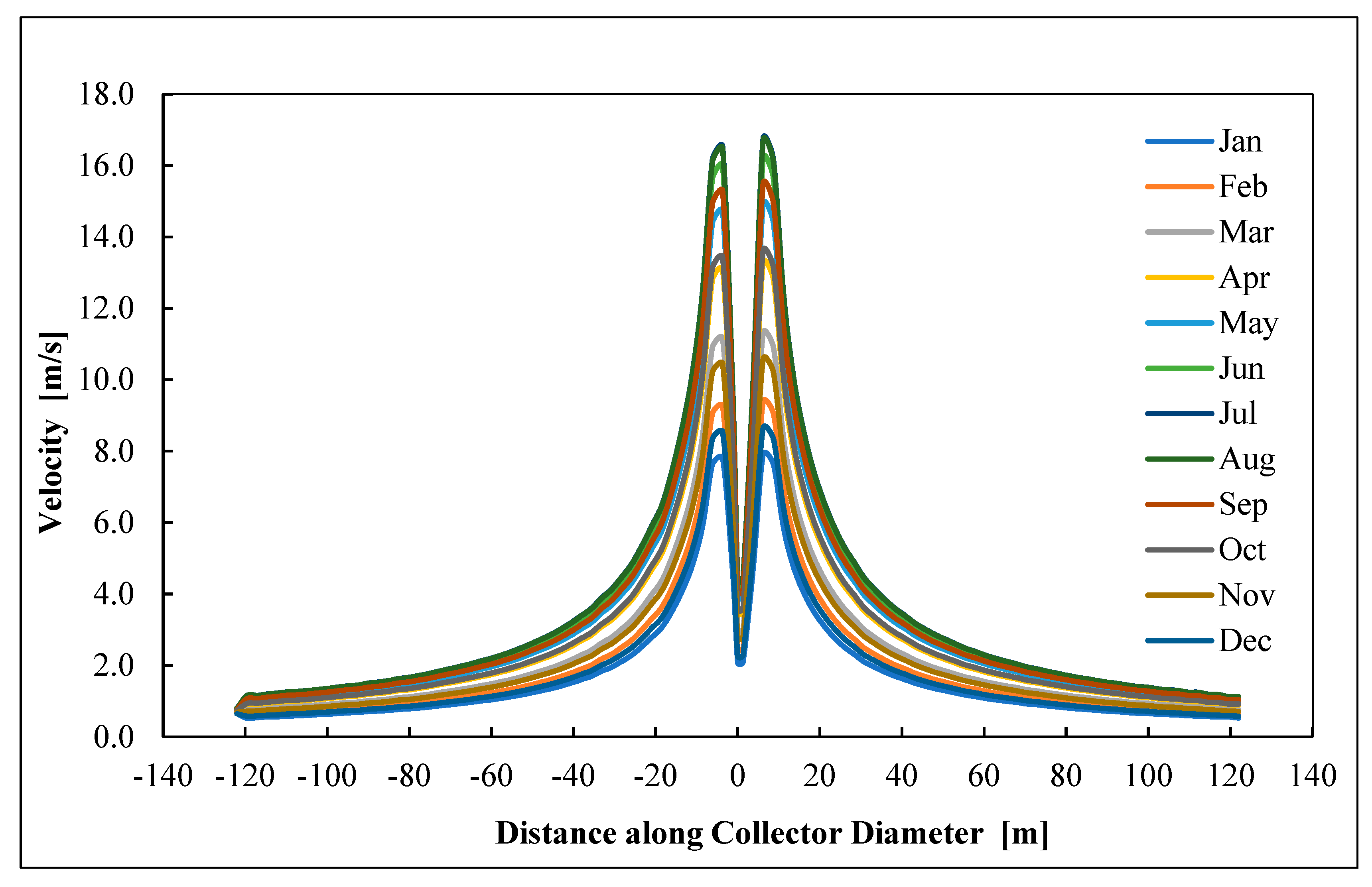




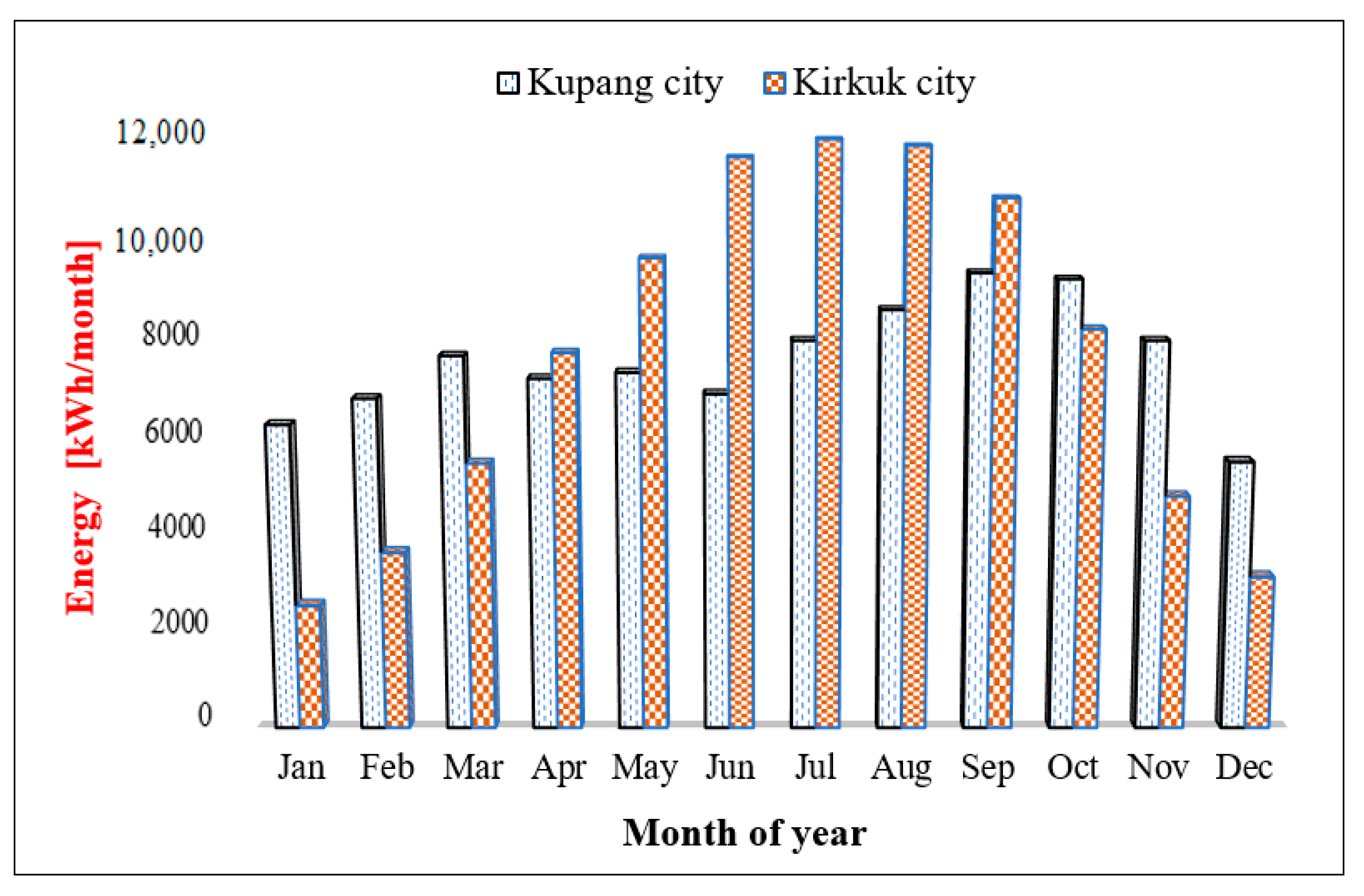
| r/R | Twist Angle (Degree) | Chord (m) |
|---|---|---|
| 0.21 | 13.7191 | 0.4682 |
| 0.25 | 11.4665 | 0.4245 |
| 0.3 | 8.7814 | 0.3646 |
| 0.35 | 7.1799 | 0.3412 |
| 0.41 | 5.1463 | 0.3154 |
| 0.44 | 4.3247 | 0.3081 |
| 0.48 | 3.2873 | 0.2851 |
| 0.52 | 2.4666 | 0.27 |
| 0.58 | 1.5599 | 0.2525 |
| 0.61 | 0.9993 | 0.2411 |
| 0.66 | 0.4389 | 0.2296 |
| 0.7 | −0.0345 | 0.216 |
| 0.74 | −0.3344 | 0.2035 |
| 0.8 | −0.7196 | 0.1848 |
| 0.87 | −1.2346 | 0.1687 |
| 0.94 | −1.6624 | 0.147 |
| 1 | −2.1345 | 0.1299 |
| Location | Type | Value |
|---|---|---|
| Collector entrance | Pressure inlet | Pgage = 0 Pa, Ta = 293 K |
| Collector outer surface | Wall (Glass) | h = 10W/(m2.K), Ta = 293K, Tsky = 0.0552 Ta1.5 |
| Ground outer surface | Wall(Soil), Modelled as Opaque surface | K = 1.83 (W/m-K) Cp = 2200 (J/kg-K), ρ = 1900 (kg/m3) |
| Ground inner surface | Wall(Soil), Modelled as Opaque surface | K = 1.83 (W/m-K) Cp = 2200 (J/kg-K), ρ = 1900 (kg/m3) |
| Chimney wall | Wall | Adiabatic |
| Chimney outlet | Pressure outlet | Pgage = 0 Pa |
| Turbine rotation | Frame Motion | ω = 100 RPM |
Publisher’s Note: MDPI stays neutral with regard to jurisdictional claims in published maps and institutional affiliations. |
© 2021 by the authors. Licensee MDPI, Basel, Switzerland. This article is an open access article distributed under the terms and conditions of the Creative Commons Attribution (CC BY) license (https://creativecommons.org/licenses/by/4.0/).
Share and Cite
Danook, S.H.; AL-bonsrulah, H.A.Z.; Hashim, I.; Veeman, D. CFD Simulation of a 3D Solar Chimney Integrated with an Axial Turbine for Power Generation. Energies 2021, 14, 5771. https://doi.org/10.3390/en14185771
Danook SH, AL-bonsrulah HAZ, Hashim I, Veeman D. CFD Simulation of a 3D Solar Chimney Integrated with an Axial Turbine for Power Generation. Energies. 2021; 14(18):5771. https://doi.org/10.3390/en14185771
Chicago/Turabian StyleDanook, Suad Hassan, Hussein A. Z. AL-bonsrulah, Ishak Hashim, and Dhinakaran Veeman. 2021. "CFD Simulation of a 3D Solar Chimney Integrated with an Axial Turbine for Power Generation" Energies 14, no. 18: 5771. https://doi.org/10.3390/en14185771







